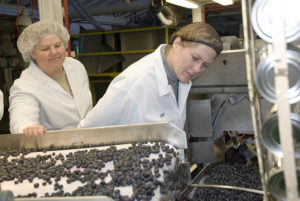Cornucopia’s Take: The FDA’s Produce Safety Rule will start going into effect next year. The cost to small farmers for implementing the proposed rules may well endanger the livelihoods of organic farmers and their customers’ access to safe and nutritionally superior local and organic food. Not all farms are alike, and the FDA rule fails to address the higher risks associated with the spread of E.coli bacteria from the mountains of manure at conventional factory farms.
THE CHALLENGE OF ASSESSING FOOD SAFETY COMPLIANCE COSTS
NSAC’s Blog
 |
In 2006, an E. coli outbreak linked to spinach grown and packed in California resulted in the infection of nearly 200 people across the country; the outbreak was so serious that in some cases the infections resulted in deaths. This serious food safety lapse was one of the key catalysts for introducing stricter requirements for food safety on California farms. Among the new protections introduced following the outbreak was the California Leafy Greens Marketing Agreement (LGMA), a food safety program with specific requirements for producers of leafy greens.
Changes to food safety requirements weren’t just confined to California, however. The 2006 outbreak also led to changes in federal food safety regulations, specifically the creation of the Food Safety Modernization Act (FSMA), which was signed into law in 2011. FSMA regulations cover the entire food supply chain – from farms to processors to transporters and imports – and shifted the Food and Drug Administration’s (FDA) operating procedure from largely reactionary to preventative.
FSMA’s new package of regulations included first-time requirements for produce farms — the Produce Safety Rule (PSR), which will come into effect for the largest produce farms starting in 2018. During the PSR rulemaking phase FDA provided some early analysis of the anticipated costs to farmers to come into compliance with the PSR, but because these regulations are new, there is limited reliable data to inform cost projections.
Recently, the US Department of Agriculture’s (USDA) Economic Research Service (ERS) released a report (click here for an article summarizing the report, and here for the full report) examining the cost of participation in LGMA as a proxy for better assessing the potential compliance costs of PSR compliance.
Report Findings
The ERS analysis took a look at five food safety areas under LGMA: food safety staff, foremen, third party audits, water testing, and refraining from harvest due to animal intrusion. According to the report, it was difficult to quantify the total LGMA-related costs incurred by each of the seven compliant farms (referred to in the report as “firms”) assessed in the study as not all of the LGMA food safety practices were reported on and could be measured. Nevertheless, the five practice areas identified provide at least an basic understanding of the farmers’ compliance costs.
The seven firms analyzed in the report averaged $196.6 million annually in fresh produce sales. The total estimated food safety compliance costs ranged from $27,150 to $305,430, with 38 percent of the cost associated with food safety staff, 32 percent for harvest foremen, 17 percent for audits, 11 percent for food that was not harvested because of exposure to animals, and 2 percent for water testing. The full ERS report is available here.
Forecasting Costs for FSMA-Compliant Farmers
In trying to gain insight into the financial impacts of FSMA compliance, comparing costs between LGMA and the PSR is somewhat problematic. For instance, there are a number of practices under LGMA which are not included in PSR, meaning that LGMA may be more costly. On the other hand, PSR practices will extend from beyond the field and into other areas of production and distribution, while LGMA only applies to food safety in the field.
Another potential issue is that the ERS study is based on data from seven large, vertically-integrated operations that grow and market product with an average of $196.6 million in produce sales. Extrapolating data from these farms to those operations that will be affected by FSMA will therefore be difficult, particularly when looking to assess the impact on smaller businesses. FDA’s original economic analysis of PSR made it clear that smaller operations would face disproportionately higher costs of compliance. For example, FDA estimated that the upfront costs of implementing the new requirements are significantly higher for smaller operations: $5,027 and $23,382 respectively for very small and small farms. At this point these figures are only estimates and do not include all potential costs that farmers may incur, such as the costs associated with getting audited by a third party, which is not required under PSR, but which farmers may decide to take on anyway due to market pressure.
In summary, while the ERS report provides interesting and informative analysis regarding the costs of compliance under LGMA, it should not be used as a proxy for assessing the cost of complying with FSMA. The National Sustainable Agriculture Coalition (NSAC) believes that additional research and evaluation focused on the costs of FSMA compliance to small and mid-size farms is critical to ensuring that FDA’s public health goals are met, while also not placing an undue burden on smaller-scale producers.
For more information, visit our FSMA website here.

